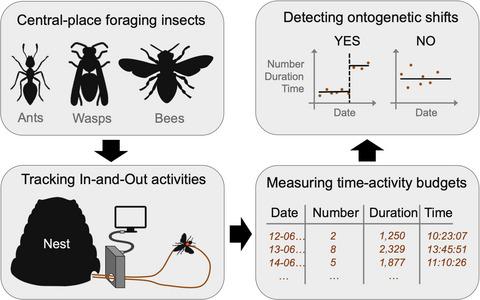当前位置:
X-MOL 学术
›
J. Anim. Ecol.
›
论文详情
Our official English website, www.x-mol.net, welcomes your feedback! (Note: you will need to create a separate account there.)
Measuring ontogenetic shifts in central‐place foragers: a case study with honey bees
Journal of Animal Ecology ( IF 4.8 ) Pub Date : 2020-06-01 , DOI: 10.1111/1365-2656.13248 Fabrice Requier 1 , Mickaël Henry 2, 3 , Axel Decourtye 3, 4, 5 , François Brun 6 , Pierrick Aupinel 7 , François Rebaudo 1 , Vincent Bretagnolle 8, 9
Journal of Animal Ecology ( IF 4.8 ) Pub Date : 2020-06-01 , DOI: 10.1111/1365-2656.13248 Fabrice Requier 1 , Mickaël Henry 2, 3 , Axel Decourtye 3, 4, 5 , François Brun 6 , Pierrick Aupinel 7 , François Rebaudo 1 , Vincent Bretagnolle 8, 9
Affiliation

|
1. Measuring time-activity budgets over the complete individual lifespan is now possible for many animals with the recent advances of life-long individual monitoring devices. Although analyses of changes in the patterns of time-activity budgets have revealed ontogenetic shifts in birds or mammals, no such technique has been applied to date on insects. 2. We tested an automated breakpoint-based procedure to detect, assess and quantify shifts in the temporal pattern of the flight activities in honey bees. We assumed that the learning and foraging stages of honey bees will differ in several respects, to detect the age at onset of foraging (AOF). 3. Using an extensive dataset covering the life-long monitoring of 1,167 individuals, we compared the AOF outputs with the more conventional approaches based on arbitrary thresholds. We further evaluated the robustness of the different methods comparing the foraging time-activity budget allocations between the presumed foragers and confirmed foragers. 4. We revealed a clear-cut learning-foraging ontogenetic shift that differs in duration, frequency, and time of occurrence of flights. Although AOF appeared to be highly plastic among bees, the breakpoint-based procedure seems better able to detect it than arbitrary threshold-based methods that are unable to deal with inter-individual variation. 5. We developed the aof R-package including a broad range of examples with both simulated and empirical datasets to illustrate the simplicity of use of the procedure. This simple procedure is generic enough to be derived from any individual life-long monitoring devices recording the time-activity budgets, and could propose new ecological applications of bio-logging to detect ontogenetic shifts in the behaviour of central-place foragers.
中文翻译:

测量中心位置觅食者的个体发生变化:蜜蜂案例研究
1. 随着终生个体监测设备的最新进展,许多动物现在可以在整个个体生命周期内测量时间-活动预算。尽管对时间-活动预算模式变化的分析揭示了鸟类或哺乳动物的个体遗传变化,但迄今为止还没有将此类技术应用于昆虫。2. 我们测试了一种基于自动断点的程序,以检测、评估和量化蜜蜂飞行活动时间模式的变化。我们假设蜜蜂的学习和觅食阶段会在几个方面有所不同,以检测觅食开始的年龄 (AOF)。3. 使用涵盖 1,167 个人终生监测的广泛数据集,我们将 AOF 输出与基于任意阈值的更传统方法进行了比较。我们进一步评估了比较假定觅食者和确认觅食者之间的觅食时间 - 活动预算分配的不同方法的稳健性。4. 我们揭示了一个清晰的学习觅食个体发生转变,其持续时间、频率和飞行发生时间不同。尽管 AOF 在蜜蜂中似乎具有很高的可塑性,但基于断点的程序似乎比无法处理个体间差异的任意基于阈值的方法更能检测到它。5. 我们开发了 aof R 包,包括大量带有模拟和经验数据集的示例,以说明该过程的简单使用。这个简单的程序足够通用,可以从记录时间活动预算的任何个人终身监测设备中得出,
更新日期:2020-06-01
中文翻译:

测量中心位置觅食者的个体发生变化:蜜蜂案例研究
1. 随着终生个体监测设备的最新进展,许多动物现在可以在整个个体生命周期内测量时间-活动预算。尽管对时间-活动预算模式变化的分析揭示了鸟类或哺乳动物的个体遗传变化,但迄今为止还没有将此类技术应用于昆虫。2. 我们测试了一种基于自动断点的程序,以检测、评估和量化蜜蜂飞行活动时间模式的变化。我们假设蜜蜂的学习和觅食阶段会在几个方面有所不同,以检测觅食开始的年龄 (AOF)。3. 使用涵盖 1,167 个人终生监测的广泛数据集,我们将 AOF 输出与基于任意阈值的更传统方法进行了比较。我们进一步评估了比较假定觅食者和确认觅食者之间的觅食时间 - 活动预算分配的不同方法的稳健性。4. 我们揭示了一个清晰的学习觅食个体发生转变,其持续时间、频率和飞行发生时间不同。尽管 AOF 在蜜蜂中似乎具有很高的可塑性,但基于断点的程序似乎比无法处理个体间差异的任意基于阈值的方法更能检测到它。5. 我们开发了 aof R 包,包括大量带有模拟和经验数据集的示例,以说明该过程的简单使用。这个简单的程序足够通用,可以从记录时间活动预算的任何个人终身监测设备中得出,



























 京公网安备 11010802027423号
京公网安备 11010802027423号